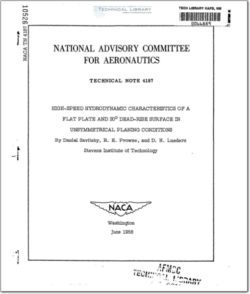NACA-TN-4187

- Version
- 216 Downloads
- 4.16 MB File Size
- 1 File Count
- December 4, 2015 Create Date
- December 4, 2015 Last Updated
National Advisory Committee for Aeronautics, Technical Notes - High Speed Hydrodynamic Characteristics of a Flat Plate and 20deg Dead Rise Surface in Unsymmetrical Planing Conditions

The results of an investigation made to obtain the wetted areas,
the three components of planing forces, and the three components of
moments acting on a 00 and a 20° dead-rise surface in high—speed, unsym—
metrical planing conditions are presented. Hydrodynamic data were
obtained for trim angles between 6° and 30°, roll angles between -l50
and 15°, yaw angles between 00 and 20°, mean wetted-length——beam ratios
up to 7.7, load coefficients up to 49.0, and Speed coefficients up to
18.0.
The collected test data are presented in summary plots which are
readily applicable for use in determining the lift, drag, side force,
pitching moment, rolling moment, and yawing moment. An analysis is pre-
sented of the variation of these quantities with unsymmetrical planing
parameters.
It was found that the wave rise at the leading edge of the tested
planing surfaces was independent of yaw angle for all test conditions.
The wave rise at the leading edge of an unrolled flat plate was equal to
that of the symmetrical planing flat plate. For the rolled flat plate,
the angle of inclination of the spray root line to the keel was identical
to that of a wedge whose dead-rise angle is equal to the roll angle. In
the case of the tested 20° dead—rise wedge, the spray root angle at the
leading edge of the rolled-down side was equal to that of a hypothetical
wedge whose dead rise is equal to 20° less the roll angle. The angle of
the spray root line relative to the keel for the rolled-up side of the
20° deadrise surface was essentially constant and independent of roll
angle.
There was a pronounced effect of finite chine-edge thickness on the
hydrodynamic forces, moments, and spray formation at certain unsymmetrical
planing conditions for a flat plate. Depending upon particular combina-
tions of planing parameters large negative or positive pressures were
developed along the length of the chine with finite thickness and noticeable
changes were observed in the spray formation associated with the affected
chine edge. Summary plots are presented which define the inception of
the chine-edge effects in terms of unsymmetrical planing conditions.
| File | Action |
|---|---|
| naca-tn-4187.pdf | Download |

Comment On This Post